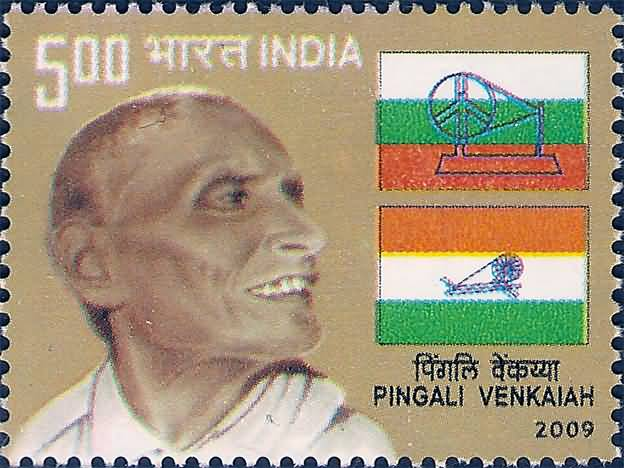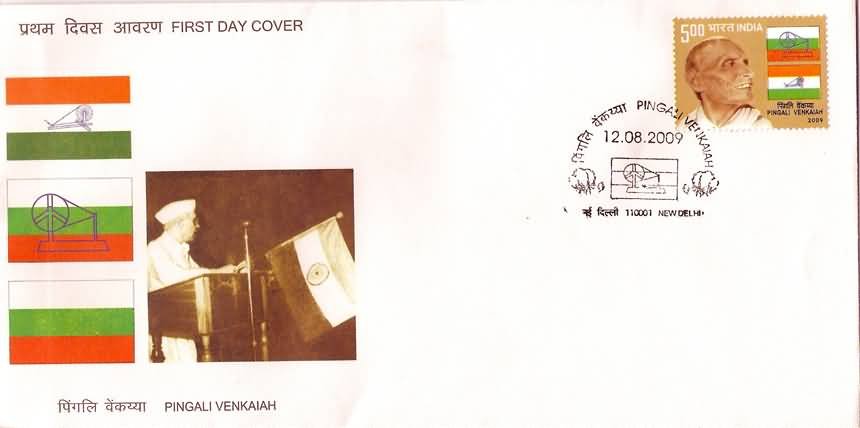Pingali Venkaiah

Technical Data
| Stamp Set | Pingali Venkaiah |
|---|---|
| Date of Issue | August 12, 2009 |
| Denomination | Rs. 5 |
| Quantity | 400,000 |
| Perforation | 13 |
| Printer | India Security Press, Nasik |
| Printing Process | Photo Gravure |
| Watermark | No Watermark |
| Colors | Multicolor |
| Credit (Designed By) | Sh. Sankha Samanta |
| Catalog Codes |
Michel IN 2397 Stamp Number IN 2337 Stanley Gibbons IN 2616 WADP Numbering System - WNS IN050.2009 |
| Themes | Commemoration | Famous people | Flags | Freedom Fighters | Men |
Shri Pingali Venkiah, the designer of the Indian National Flag was born to Shri Pingali Hanumantha Rayudu and Smt. Venkataratnamma, on 2nd August 1876 at Bhatlapenumarru, Divi taluk, Krishna District, Andhra Pradesh.
He had his primary education at his village and High School education in Hindu High School, Machilipatnam. Driven by patriotic zeal, at the age of 19, he left for Bombay (Mumbai) and joined the Army. On completion of the training, he was sent to Africa where he participated in the Boer War (1899–1902). While in Africa he met Gandhiji and was deeply impressed with his ideology.
On his return, he worked as a Railway guard. In those days, Madras (Chennai) was reeling under a plague epidemic. The plight of the people moved Shri Pingali Venkiah. He quit his job in the Railways and obtained training as Work Inspector and worked as a Plague Disease Eradication Inspector in Madras.
Shri Pingali Venkiah was an original thinker and versatile genius. Whether it was learning various languages, or the study of diamonds or geology or agriculture, he proved that where there is a will there is a way. There is an interesting story attributed to him. In 1904, it so happened that Japan conquered Russia. This victory of Japan over Russia affected Shri Pingali Venkiah so deeply that he learned the Japanese language. He also mastered Urdu and Sanskrit.
When Gandhiji started the Khadi Movement, Shri Pingali Venkiah was inspired and imported cotton seeds from America, known as the Cambodian variety, created a hybrid with Indian cotton seeds. This unparalleled research resulted in a stupendous success which earned him the title of “Patti (cotton) Venkiah.” The British government in recognition of his contributions conferred on him an honorary membership of the Royal Agricultural Society of London.
In 1906 the Indian National Congress conducted its 22nd Session at Calcutta (Kolkata). Shri Pingali Venkiah participated. Dadabhai Naoroji, known as the Nation’s grand old man, presided over the meeting. He appreciated the selfless services of Venkiah. Shri Pingali Venkiah was elected as a member of the Congress Executive meeting. In that meeting the Union Jack was hoisted in the Congress Maha Sabha which hurt him when he observed that the British ‘Jack’ flag was honoured by the Indians in spite of their desire to become independent. Since then he relentlessly pursued his goal to give shape to a National Flag.
In 1916, he published a book “A National Flag for India” in English in which he put forth 30 models for National Flag.
During the meeting of the Indian National Congress held at Vijayawada, in April 1921, Mahatma Gandhi asked Shri Pingali Venkiah, to draw a National Flag. Thus the responsibility to design the Indian flag was formally handed over to Shri Pingali Venkiah. Gandhi approved the design of National Flag in the Indian National Congress Conference.
Expressing his views on Shri Venkiah in the “Young India” newspaper under the heading “Our National Flag”, Gandhiji wrote:
“We should be prepared to sacrifice our lives for the sake of our National Flag. Pingali Venkiah, who is working in Andhra National College, Machilipatnam had published a book describing the flags of the countries, and has designed many models for our Indian National Flag. I appreciate his hard struggle during the sessions of Indian National Congress for the approval of Indian National Flag. When I visited Vijayawada, I asked Mr. Venkiah to prepare a two coloured flag with the red and green colours along with a charkha symbol and obtained it within three hours from him, later we had decided to include the white colour also the colour that reminds of truth and non-violence.”
Thereafter Pingali Venkiah became popular as Jhanda Venkiah.
Shri Pingali Venkiah breathed his last on 4th July, 1963.
First Day Cover

